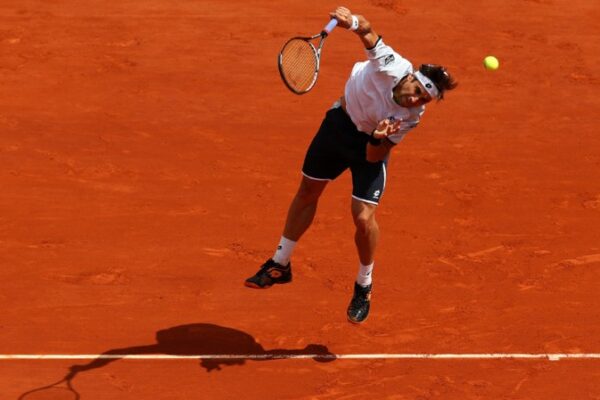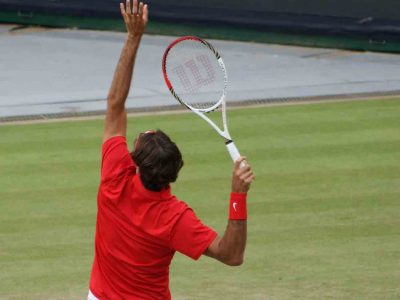
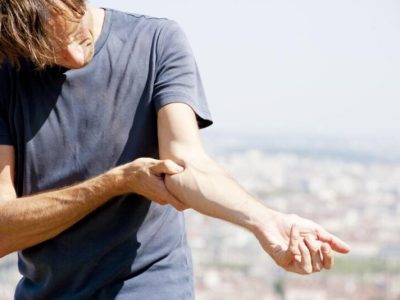
Tennis Elbow and Golfers Elbow
Golfers Elbow
Golfers Elbow is pain and tenderness on the inside of the elbow. This does not have to be caused by golf. In fact many professional tennis players suffer more from Golfers elbow than Tennis elbow! This is not due to poor technique but caused by the service action during which the wrist is bent at the same time as the forearm is turned inwards. This is increased by hitting an exaggerated top spin.
In right handed Golfers they may well develop tennis elbow in their leading Left elbow and Golfers elbow in the right one.
Tennis elbow
Tennis Elbow ( or Lateral Epicondylitis) is pain on the outside of the elbow. This does not have to have been caused by tennis although frequently it is. It is also caused by repetitive strain such as painting, work in the garden, heavy lifting and such like. Studies have shown that 45% of athletes who play tennis daily, and 25% of those who play twice a week have suffered from it. It is even more common in athletes over 40.
The problem arises in the area of a small bony protuberance (the lateral epicondyle) on the outside of the elbow, which is the site of origin of the muscles, which extend the fingers and wrist. Because this extensor origin is small, the forces, which develop in the muscles create a high load area. These tendons can be easily inflammed with overuse or sustain an acute injury, which causes the pain. And if the irritation continues then the inflammation can change into degeneration. This happens because tendons generally do not have a very good blood supply and if there is very little blood flowing through it then it doesn’t get much oxygen or many nutrients from the blood. And when you make a fist and tense up the forearm muscles, what little blood there was going to the tendon decreases even further. So no blood means no oxygen and no nutrients and if a tissue is starved of those things then it can actually start to die. That sounds rather dramatic and the technical term we use is degeneration but it amounts to the same thing.
Initially there can be a lot of inflammation, which is why anti-inflammatory tablets or creams can help and also why steroid injections may help. However they do not help with the longer term degeneration and so other treatments may have to be considered..
Symptoms of Tennis Elbow
The usual problems are pain in the forearm on the outside of the elbow and the point of the elbow and can radiate along the upper arm and down the forearm. lifting the kettle, or holding a pen.
This is usually combined with weakness of the wrist and can cause difficulty with simple daily tasks such as lifting the kettle, or holding a pen.
There is usually a distinct tender point over the outside of the elbow.
This painful spot is usually made worse by extending the fingers against resistance and also by bending the hand backwards against pressure.
This means it can affect any sports that require gripping something eg.using weights in the gym, holding a tennis, badminton or squash racquet or a cricket bat and golf club. It can also affect people who have jobs that involve gripping and lifting such as painters, plasterers and brick layers.
Be sure that your racquet grip is the correct size.

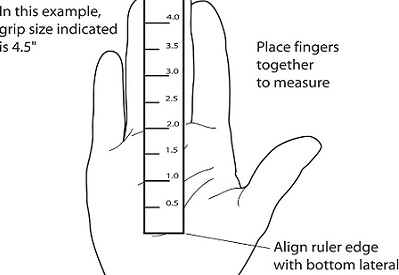
Treatment
There are many different ways to treat Tennis Elbow. Many of them resolve with a mixture of rest, physiotherapy, stretches and wearing a tennis elbow strap.The important thing is to take a break from the thing that caused it in the beginning( around 6 weeks)
Some people in mild cases continue playing tennis but with a strap. It is also worth putting a shock absorber in the racquet, concentrating on good technique and also do not play with wet balls.
Sometimes it does not resolve and an injection is offered. Many people respond well to a steroid injection especially whilst it is in the early stages (first few months). This is while it is just at the inflammatory stage. There should be a clearly tender point to inject.
The injection is better done under ultra-sound control by a radiologist. In fact the injection goes around the tendon rather than straight into it. It is better not to allow the GP to have a go as you may then have to repeat it under the care of a Radiologist.
The injection should not, if done effectively, cause much pain and should improve the elbow in a week or two.
If you developed the problem after a fall or hitting the elbow then it is probably worth having an MRI scan.
In some cases a second and occasionally a third injection may be given to totally cure the problem, however repeated steroid injections are not recommended. Tennis elbow is generally a self limiting condition and should resolve with a decent period of rest and physiotherapy.
There are quite a few other treatments available that do not seem to have any strong evidence that any of them really work such as Extra-Corporeal Shock-wave Treatment (ESWT), GTN patch therapy or injecting PRP.
In some cases this does not work and surgery is then an option.
Physiotherapy
It is definitely worth going to see the physiotherapist.
Many cases of tennis elbow are caused by tightness around the neck and the muscles down the arm. The physiotherapist will assess the cause of the elbow pain and treat them as well as showing some stretches and the correct strengthening exercises.
Ultrasound over the point of pain is also worth trying. Ultrasound helps aid healing and has an anti inflammatory effect.
Acupuncture has also been shown to give some relief.
Ice and local anti-inflammatory gel placed over the extensor tendon origin are also worth trying.
You can also discuss the possible causes of strain with the physiotherapist to enable you to change to prevent further occurrences.
The physiotherapist will also help recommend the right tennis elbow strap to wear and where to place it. The strap is designed to take the pressure off the tendon and allow the inflammation to settle. It may be worth wearing all day if simple household tasks are causing pain.
Exercises
Stretches and progressive strengthening exercises involving the use of weights or elastic bands can be helpful. They can increase pain-free grip strength and forearm strength.
Exercising during a case of tennis elbow is vital for regaining muscle strength and reducing pain.
Despite painful sensations, it is possible to ease into an exercise routine through initial stretching. The most important part of managing tennis elbow is persisting with a daily regimen of stretches and lifts. Start with low weights and increase the difficulty of the movements until it is only possible to complete ten lifts.
The physiotherapist will show you the exercises and stretches to perform
Stretching Exercises for Tennis Elbow
Wrist flexor stretch
- Extend your arm in front of you with your palm up.
- Bend your wrist, pointing your hand toward the floor.
- With your other hand, gently bend your wrist further until you feel a mild to moderate stretch in your forearm.
- Hold for at least 15 to 30 seconds. Repeat 2 to 4 times.
Wrist extensor stretch
- Repeat steps 1 to 4 of the stretch above, but begin with your extended hand palm down.
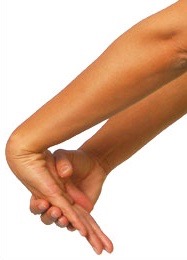
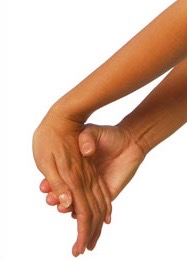
Prevention
Tennis and Golfers elbow in tennis players can be caused by faulty stroke technique. Faulty backhand often causes tennis elbow whilst faulty forehand may cause Golfers elbow.
In amateur players the fault in the backhand may come from using too much wrist and not keeping the wrist firm and using the whole arm. Hitting a ball at 50 kph is the equivalent to lifting a 25kg weight. The forces that arise when the ball hits the racquet have to be distributed over the whole body, shoulder and trunk. It may be advisable to have a session with a coach to see if there are any obvious mistakes
The things to emphasize are
1. Good foot work so you approach the ball correctly
2. The ball should be hit correctly at the right moment
3. The shoulder and the whole body should take part in every stroke so that “braking” does not occur when the ball is hit. The stroke should follow on through and the wrist remain firm.
4. Make sure the balls you are playing with are neither wet nor dead.
5. Check your equipment such as weight and stringing of racquet for your ability and the grip size are correct for you. You can also add a dampener into the strings which helps take away some of the vibration through the racquet.
Correct grip size can be determined by measuring the distance between the mid line of the palm of the hand and the tip of the middle finger. This measurement should then be approx. equal to the circumference of your racquet grip.
6. The statistics show a huge difference in the numbers of people who develop tennis elbow between those who play twice a week rather than three times a week.
It may be sensible to cut down the sessions played.
Tennis and Golfers Elbow are difficult conditions to treat. There are a huge range of options all of which might work for some people but none of which works for everybody. We should only be using evidence based treatments that have been shown to work and the trouble is that very few have so we are left with Rest, Ice, Straps, Physiotherapy, Injections, Time and lastly surgery if all else fails.
Elbow Braces
There are many different ones to chose from but the basic principle is to hold the tendon down on to the bone preventing further strain. You can wear them just for sport or if you are having a lot of day to day pain you can wear all day doing household chores.
Simien tennis elbow brace
Get high-quality performance at an affordable price with Simien tennis elbow brace. The smart design of this brace work on targeted muscles in your arm, rather than working on all of them, and restricting the movement. The band is made of neoprene and nylon for comfort and flexibility.
Playactive 2-Pack Tennis elbow brace with compression pad
PlayActive braces are designed to help people who suffer from tennis/golf elbow and associated conditions. The braces come with extra support straps to fit small-large forearm sizes appropriately. In the package, you will get two elbow support braces that are built to last. The hooks and straps keep the braces in place, even after regular use. The compression pad in the braces is comfortably soft but strong enough to provide adequate support.
Witkeen elbow brace with compression pad
Prevent injury and chronic elbow pain by using high-quality tennis elbow brace from WITKEEN. This tennis elbow brace is made of 80% neoprene and 20% nylon for perfect fit and comfort. Relieve your muscle tension and pain caused due to tennis/golf elbow. Don’t let repetitive stress motion injuries keep you indoors anymore.
MCDAVID 489 elbow strap
All the braces from McDavid are of premium quality and made of 100% latex-free neoprene. Built to perfection, this is the best brace for tennis elbow because it provides ample compression and balanced support to the soft tissues. Its specialized ThermaVent Moisture Management makes the strap breathable, keeping the athletes cool and dry. Its HexPad technology works wonders in making the strap long lasting and light weight, providing maximum protection.

